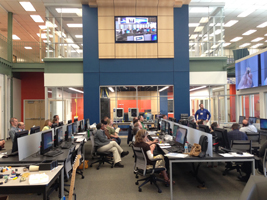Coinciding with the National Maker Faire held right here in D.C. just last week, this “Week of Making” features innovative makers from across the country.
In honor of this “Week of Making” we compiled a list of some of our all-time favorite maker projects we’ve seen in recent years.
The HooPrint
This is by far one of our favorites on this list. Students at The University of Virginia used Dimension and uPrint 3D printers to build 3D printed 2D printers, called a HooPrint (named after the school’s beloved mascot).
As part of this project, students learned about stepper motors, brush motors, limit switches and software engineering to make eight mechatronic plotters out of 3D-printed parts. Students even created an “etch-a-sketch” mode in which they developed a fly-by-wire control system.
3D Printed Rats for Dissection
Here’s a new one we learned about at last week’s National Maker Faire. Startup NecropSynth aims to make quality scientific education more accessible and affordable while reducing students’ exposure to harmful chemicals through 3D printed rats for dissection.
[one_half valign=”top” animation=”none”]
NecropSynth uses a PrintrBot and a more advanced multi-material printer that allows for the creation of models with harder material that represents bones and surrounding softer material that represents muscle. The end result is a realistic rat that can be used as a teaching tool.
We see similar methodologies at medical schools where professional 3D printers create realistic medical students can learn all kinds of surgeries and medical practices on. NecropSynth’s rats bring the concept to high school biology classrooms.
[/one_half]
[one_half_last valign=”top” animation=”none”]

[/one_half_last]
3D Printed Guitar
Okay, so we’re a little biased on this one because this guitar was made by our consultant, Alex Baddock. He showed it off at the White House Maker Faire in 2014 and we’ve since taken it on the road with us to many of our events.
Alex designed the body of the guitar using SOLIDWORKS design software and purchased a guitar neck from the Internet. He then scanned the neck using a Creaform HandySCAN 3D scanner and used this scan data to cut the neck pocket in his SOLIDWORKS design. He then printed his final design of the guitar body in modular pieces using a Stratasys uPrint Plus.
Not bad, eh?
RoboTar
In vein with the music related maker movement, the RoboTar is a neat invention that takes over fret-work so that playing a guitar is as simple as strumming or finger-picking while you change chords with a foot pedal.
A culmination of 3D printing technologies plus off the shelf hardware and electronics, RoboTar also comes with software that runs on a laptop, PC or Android device. You basically use the software to put chords in a sequence order you plan to play then read your screen like it’s a sheet of music as you play along.
The device is most popular with singers or composers who want to accompany themselves or for younger kids learning to play the guitar but perhaps their fingers are too delicate to hold down the strings on the fret.
Touch Board
Next on our list is the Touch Board from Bare Conductive. Touch Board turns any conductive material into a potential capacitive touch input, including Bare Conductive’s conductive electric paint.
All you need to play with this Make is a battery, a speaker, an SD card, and the Touch Board, which is based around an Arduino Leonardo board and a custom chip that allows the Touch Board to act as a capacitive sensor.
Touch sensitive light switches, motion sensors, or a piano brushed with paint onto any surface… all of the creative possibilities are what makes the Touch Board so much fun.
Prosthetics
We’re excited about just about anything and everything that comes out of the e-NABLE community.
This is where you see tinkerers and makers – oftentimes students and university professors – come together to create some of the most life changing 3D printed devices.
A volunteer network using 3D printers to design and create free prosthetic hands for those in need, this is a community of individuals who are truly working with 3D printing technology to better the world by bettering the quality of life of others.
Here’s just one example of one of our favorite stories to come out of e-NABLE:
What are some your favorite Make’s from over the years?



